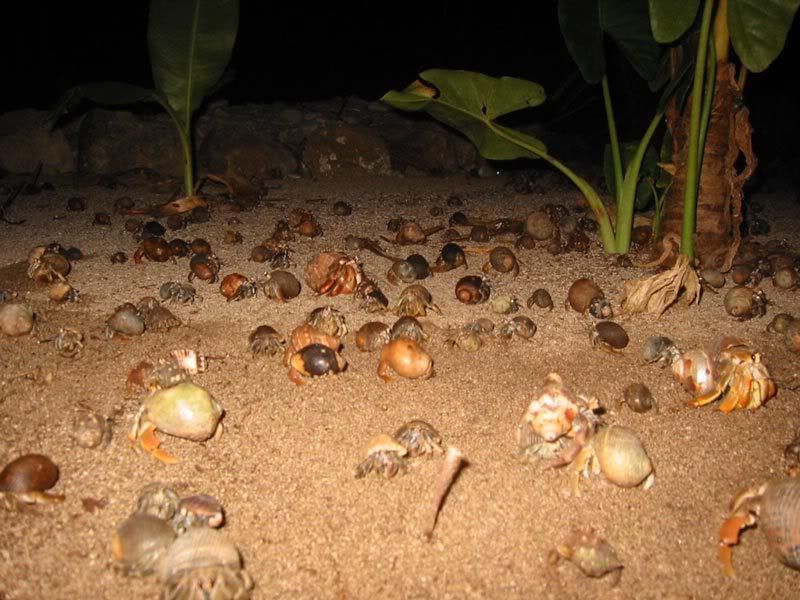
Land hermit crabs live in very large groups, sometimes over one-hundred crabs, with many different sizes. Indeed , the crabs will never exhibit most of their normal behaviors unless they are kept in a social environment.
In captivity, land hermit crabs are typically kept in groups of five to fifty crabs or more, usually of slightly varying sizes. In nature as well as captivity, hermit crabs will develop a sort of social hierarchy within the group, typically with larger crabs almost always at the top. The benefits to being at the top of the social chain seem to be 'first dibs' on food and hiding spots and shell choice, respectively. Crabs of roughly the same size, seem to be on the same level of the social status.
In this picture, you can clearly see the extreme size differences crabs may have. Very large crabs typically seem to ignore very small crabs for the most part, even letting them eat from the same piece of food on occasion.

Watching the interaction between the crabs is very entertaining , in fact, it is one of my most favorite things about this hobby. There are exceptions to the 'Larger over Smaller' rule. Some individuals do not exhibit dominant behaviors over their smaller counterparts, in fact, some seem to actually enjoy 'hanging out' with one of the 'little dudes', carrying them around on the back of their shells and such, which is very comical to watch.
It is important to be able to recognize 'Dominate' versus 'Aggressive' behaviors, sometimes I feel that the two are often confused by hobbyists. Aggression may indeed be dominate behavior albeit, a more competitive one. Sometimes a crab-usually newly added- will repeatedly bother the same individual, usually be flipping them onto their backs. I personally think that in this sort of situation, the newly added crab is trying to assert his place in the colony and one crab in particular might be considered a threat to his social standing. The reverse is also true, crabs in the existing colony may show aggressive/dominant behavior too newly added crabs. Usually, aggression dies down in a week or two. Sometimes a particularly 'aggressive' individual is considered a threat to the life of the other 'peaceful' crabs, and is removed from the colony. I personally think this only causes increased stress to the crab and I do not recommend it.
The best time to view the state of the social hierarchy in my opinion is during feeding. The larger crabs almost always get to the food first, with their smaller brethren arriving later. Unless crabs are on the same level or either very tolerant, the larger crabs will usually not let the smaller ones feed from the same piece of food, if one draws near to take a bite, the larger crabs will gently 'flick' them away with one of their legs, the smaller crab will recover quickly and move on to find his own piece, or share with another crab of similar size. However, this is not always the case, I have had a few very large crabs share the same piece of food with several of his smaller counterparts, gently giants indeed!
Shell fights are often considered 'aggression' however, this is easily remedied, and usually only happens if there is not enough suitable shells available, or not enough of the same type of shell. If a crab continues attempting to steal a shell from another, I recommend purchasing more shells of the type the victim crab is wearing. Shell preference varies between species, so if you are mixing species, I recommend researching the shell preference of the species you keep and adding shells accordingly .
For the most part, I try to bother my crabs as little as possible, so even if I witness 'aggressive' behavior, I am secure in the knowledge that the crabs will figure it out themselves. Like I said , overly dominant or 'aggressive' behavior typically stops within a week or two. Just let them figure out their own social problems.
If you are setting up a new colony, I recommend starting out with five more more crabs of slightly varying sizes. This way there will not be as much competition between them.
Cheers.
S.P
No comments:
Post a Comment